Welcome to the twenty-second installment of More Than Words, where I take queer words of all sorts and smash them apart and see what makes them tick. Every week I’ll be dissecting a different word, trying to figure out where it came from, how it has evolved, where it might be going, and what it all means. It’s like reading the dictionary through a prism. Feel free to send word suggestions to [email protected].
Header by Rory Midhani
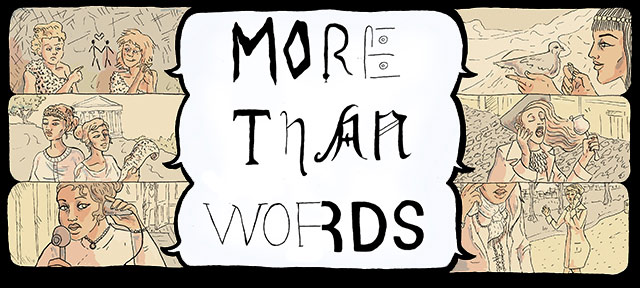
It’s that time again! Time for me to drag all my dictionaries up a mountain and hang out with a bunch of amazing, smart, variously-identified people for a week. This past spring, I wrote about the history of the word “camp,” which involved oxen, army training, and Susan Sontag. I’ve decided to go a bit more lighthearted this time and give you the lowdown on a few camp-related words that happen to have interesting histories. Shoulder your pack and climb on in.
(p.s. Don’t fear, regular readers — our exploration of the word “feminist” will resume next time!)
S’more
This one’s so intuitive, I probably could have probably figured it out even without my fake diploma from Queer Etymology University. Just as a s’more is a melty portmanteau of graham crackers, chocolate, and marshmallow (plus sometimes peanut butter cups, if you are a nut yourself), the word “s’more” is an abbreviation of the phrase “some more,” squished together the way you would pronounce it if, say, your mouth were totally stuffed.
But who started calling them “s’mores” in the first place? It’s a rare food that’s named after an abstract request. I had originally guessed Oliver Twist, based on his showstopping line.
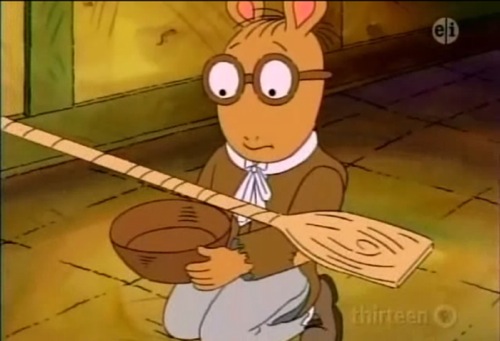
DOES ANYONE ELSE REMEMBER THIS ARTHUR EPISODE (VIA ARTHUR OUT OF CONTEXT)
But a little digging revealed the culprits to be none other than that most legendary girl gang, the Girl Scouts. A 1925 article in The Norwalk Hour details an outdoor meeting during which Miss E. Simmons, fresh from a troop management course, introduced two new “dishes” to her local patrol leaders —”Kabobs” and “Some Mores.” Both “dishes” were “enjoyed thoroughly” (quotation marks the Hour’s. I pass no judgement on “Kabobs.”). Two years later, as part of their endless quest to monetize delicious sweet things, the Girl Scouts published the first official recipe for “Some Mores” in their 1927 classic handbook, Tramping and Trailing with the Girl Scouts. The recipe calls for two marshmallows toasted to “a crisp gooey state” and placed inside a “graham cracker and chocolate bar sandwich” (recommended chocolate: “Hershey’s or any of the good plain brands”), and ends with this dumb advice: “Though it tastes like ‘some more,’ one is enough.” According to the Online Etymology Dictionary, the phrase shortened into a “childish contraction” about ten years later, in 1937. So remember, when you ask for that second s’more, you are being officially greedy and childish. Perfect.
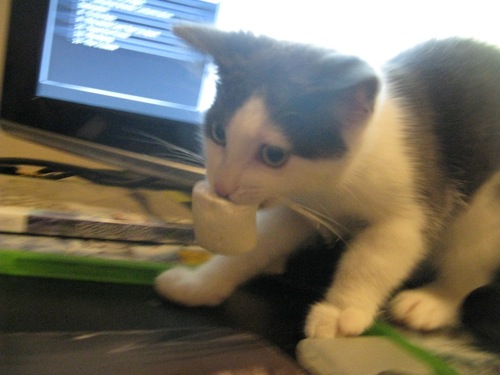
LET’S BEGIN.
Bandana
Did you know that you can do at least 180 things with a bandana, probably more? I bet that’s partly because a bandana (unlike, say, a neckerchief, or a bow tie) is not named for how you wear it or tie it, it’s named for how it’s made. So although it’s somewhat defined by its origins, its future is wide open.
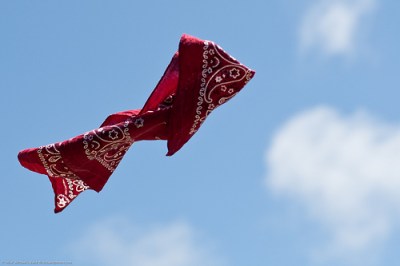
MAY WE ALL BE MORE LIKE THE BANDANA
“Bandana” stems originally from the Proto-Indo-European root *bendh, which meant “to bind.” When it splintered into other languages, *bendh led to contemporary words like “band” (Old Norse) and “bend” (Old English). It also became the Sanskrit word “badhnati” (“he binds”). According to the Hobson-Jobson Definitive Glossary of British India, this became “bandhnu: a mode of dyeing in which the cloth is tied in different places, to prevent the parts tied from receiving the dye.”

THE BANDHNU PROCESS. IF YOU LOOK CLOSELY YOU CAN SEE THE STRINGS (VIA DESIGN RESOURCE)
This type of dyeing and the dyed cloths themselves became etymologically conflated, and the name of the cloth slowly morphed. An 1817 record from the British House of Commons describing the recovery of “Six Bales of Prohibited East India Goods” from the Sloop George records “6 China Silk Crapes, 80 Bandannoes, [and] 6 Flowered Taffeties” among the seized items. to “bandanna” (1813) to the modern incarnation everyone knows, loves, and flags with. I would like to take this opportunity to officially endorse the yellow team for A-Camp 4.0.
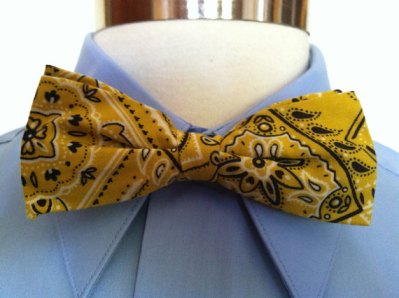
WATERSPORTS 4EVER (VIA WHIPPERSNAPPED)
Bear
Did you know that if a bear charges you, you’re supposed to “let it know you’re human” by speaking softly and waving your arms around? Next time you’re in the line of fire, do arm-waving one better — establish your humanity by educating the bear about the history of its name. “Oh look, a bear,” you could say (softly), “from the Proto-Germanic “*beron,” for “the brown one,” right? Which itself comes from the PIE root *bher-, for “brown,” a root that also led to “beaver” and “fry” (because of that secondary sense of “brown,” “to cook”).”

IS THIS WHERE WE’RE MAKING MOONCATCHERS?
“But even more interesting,” you say, as you gently wave your arms, “is the generally-respected theory that the original PIE root was actually *rkto (as in Arctic), but it was gradually replaced in many European regions because of the Hunter’s Taboo — a strong belief that using the true name of an animal would allow it to evade you.” The bear slows down and cocks her head, suddenly interested.
“So bears like you got all sorts of nicknames. Russians called you “honey-eater,” the Welsh “honey-pig.” Lithuanians called you “the licker” (no joke). Irish people went with “the good calf.” Scandinavians called you “Bjorn,” which is like Americans calling you “Bobby.” And the Germans called you “the brown one.” That’s the one that crossed the sea and stuck.”
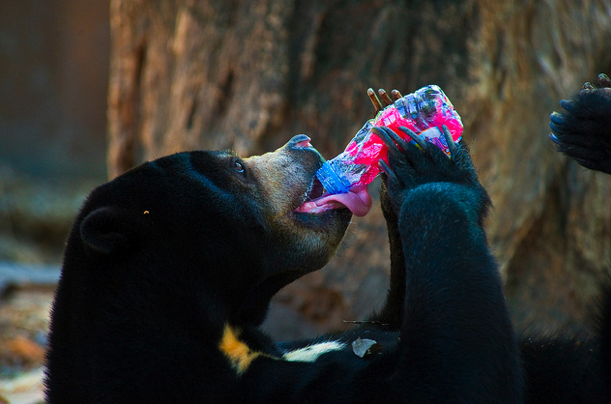
HYDRATION IS REALLY IMPORTANT, ESPECIALLY AT ALTITUDE.
Is the bear slowing down? Well done! If it isn’t, I don’t think I can help you any further. I’ve done all I can. I’m sorry.



cara i don’t know you but i love you
I am in fits of laughter over the bear section. Cara, you are a comedic genius.
Black bears are not the same as grizzly bears. Black bears only try to eat you when they are for real starving.
Bears. Beets. Battlestar Galactica.
that cat is adorable. why is it making off with a marshmallow? i’m just imagining myself confronted by a bear and waving my arms and trying to talk gently but running out of interesting things to distract the bear with because i did not commit the bear passages to memory.
also, my purple bandana got me through today.
1. “Though it tastes like ‘some more,’ one is enough.” NO WAY. Even Girl Scouts eat two s’mores per campfire.
2. Unfortunately, there are too many peanut allergies in this world to make s’mores with peanut butter cups. I hope that at A-Camp you are able to do this. (May I also suggest using Girl Scout cookies rather than graham crackers?)
3. I love that you called us the most legendary girl gang. I would like to adopt that phrase, please and thank you.
4. We regularly go on “bear hunts.” I feel that justifies #3.
The link to “Why I hate s’mores” is rather depressing though. The author says:
“An introverted child incapable of small talk, with brothers and no sisters, I was freaked out by the enforced sororal chumminess of Girl Scouts… But really, it was their friendly yammering that spooked me. I did not know how to yammer, then. I could, however, make s’mores over the campfire and pretend to like them in a doomed bid to fit in. Peer pressure starts early; it’s hard to “just say no” to s’mores.”
…Girl Scouts DON’T fit in. That’s why camp is so awesome. It tends to be a big conglomeration of girls who generally don’t fit into the rest of the world. But that’s just my two cents.
Sincerely, your friendly Girl Scout Camp Director
CARA THE BEAR SECTION OF THIS IS EVERYTHING I NEVER KNEW I WANTED